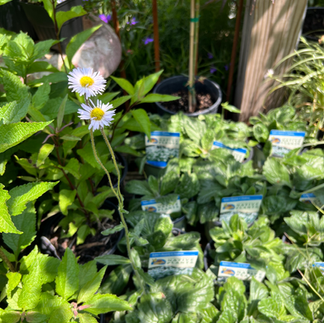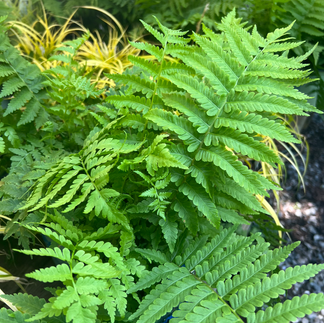Pollinator Basics
- MustardSeedMarket

- Jun 19, 2023
- 3 min read

Pollinators are central to gardening and are also a critical part of our ecosystem! The Mustard Seed Market is a member of the non-profit NAPPC (North American Pollinator Protection Campaign) and a supporter of Pollinator Week. At the garden center, we offer seasonal integral pollinator plants to our community and surrounding areas. Join us as we celebrate Pollinator week June19-25th and learn more about why pollination is so important!
What is a pollinator?
A pollinator is anything that helps carry pollen from the male part of the flower (stamen) to the female part of the same or another flower (stigma). The movement of pollen must occur for the plant to become fertilized and produce fruits, seeds, and young plants (National Park Service).

Who are pollinators?
Birds, bats, butterflies, moths, flies, beetles, wasps, small mammals, and most importantly, bees are pollinators. They visit flowers to drink nectar or feed off of pollen and transport pollen grains as they move from spot to spot (Pollinator Partnership).
Why are pollinators important?
One out of every three bites of food you eat exists because of the efforts of pollinators, including many fruits, vegetables, and seeds. Pollinators not only are necessary for our own food, but support the food and habitat of animals.
Healthy ecosystems depend on pollinators. At least 75 percent of all the flowering plants on earth are pollinated by insects and animals! This amounts to more than 1,200 food crops and 180,000 different types of plants—plants which help stabilize our soils, clean our air, supply oxygen, and support wildlife.
In the United States alone, pollination by honey bees contributed to over $19 billion of crop production in 2010, while pollination by other insect pollinators contributed to nearly $10 billion of crop production (National Park Service).
"Without the actions of pollinators, agricultural economies, our food supply, and surrounding landscapes would collapse (Pollinator Partnership)."
What are Native plants?
Native plants are the indigenous terrestrial and aquatic species that have evolved and occur naturally in a particular region, ecosystem, and habitat (USDA).

Are all pollinator plant species native?
No, not all plants that attract pollinators are native species. Pollinators require specific plants which provide nutrition and habitat to larval (immature stages) and adults pollinators. Non-native plants may attract pollinators away from native species that are more nutritious and better food sources.Non-native species of pollinators may also compete with native pollinators for pollen and nectar. (National Park Service).
Pollinators have evolved with native plants, which are best adapted to the local growing season, climate, and soils. Most pollinators feed on specific plant species —hummingbirds sip nectar from long, tubular honeysuckle flowers, while green sweat bees prefer more open-faced sunflowers. Non-native plants may not provide pollinators with enough nectar or pollen, or may be inedible to butterfly or moth caterpillars (USDA).
What is the difference between a native and native cultivar (nativar)?
As mentioned before, a native plant is one found naturally in an area prior to European settlement. A cultivar is a plant that has been bred by horticulturists through cloning or hybridization to enhance desirable qualities, such as disease resistance or longer bloom time (Total Landscape Care).
What are some native plants for pollinators?
Trees & Shrubs:
Calycanthus floridus (Sweet Shrub)
Cephalanthus occidentalis Crimson Comet (Crimson Comet Buttonbush)
Cercis Canadensis (Eastern Redbud)
Filipendula ulmaria (Meadowsweet)
Fothergilla x intermedia (Bottlebrush Legend Of The Small)
Hydrangea arborescens (Smooth Hydrangea)
Kalmia latifolia (Mountain Laurel)
Rhododendron catawbiense (Catawba Rhododendron)
Rhododendron calendulaceum (Flame Azalea)
Hypericum densiflorum (Bushy St. John’s-wort)
Perennials & Grasses:
Aquilegia canadensis (Columbine)
Asclepias tuberosa (Butterfly Weed)
Athyrium angustum forma rebellum (Lady In Red Fern)
Carex laxiculmis (Bunny Blue)
Chasmanthium latifolium (Northern Sea Oats)
Chelone obliqua (Tiny Tortura Turtlehead)
Dennstaedtia punctilobula (Hay Scented Fern)
Echinacea purpurea (Purple Coneflower)
Eragrostis pectinacea (Purple Lovegrass)
Erigeron pulchellus var. pulchellus 'Lynnhaven Carpet' (Robin's Plantain/Fleabane)
Eupatorium (Hardy Ageratum)
Eupatorium maculatum 'Dwarf Red' (Spotted Joe Pye Weed)
Heliopsis helianthoides (False sunflower)
Heuchera villosa (Rock Alumroot)
Hypericum calycinum (Aaron's Beard)
Liatris spicata var. spicata (Dense Blazing-star)
Lobelia cardinalis (Cardinal Flower)
Lobelia siphilitica (Great Blue Lobelia)
Matteuccia struthiopteris (Ostrich Fern)
Monarda didyma (Bee Balm)
Muhlenbergia capillaris (Muhly Grass)
Phlox paniculata 'Laura' (Garden Phlox)
Polystichum acrostichoides (Christmas Fern)
Pycnanthemum verticillatum var. pilosum (Hairy Mountain Mint)
Rudbeckia fulgida (Black-eyed Susan)
Rudbeckia triloba (Brown-eyed Susan)
Sporobolus heterolepis (Prairie Dropseed)
Stokesia laevis 'Blue Danube' (Stokes Aster)
Tiarella cordifolia (Foam Flower)
Visit the Mustard Seed Market at 5589 US HWY 321-S in Blowing Rock, NC.
Visit this link for more information on pollinators and plants for our area: https://pollinator.org/PDFs/Guides/CentralAppalachianrx7FINAL.pdf
Sources:




























Comments